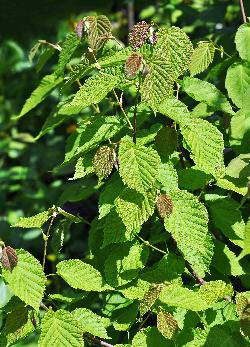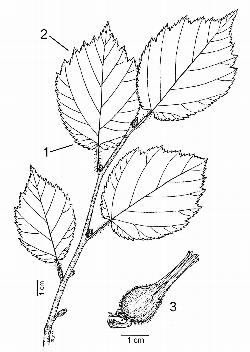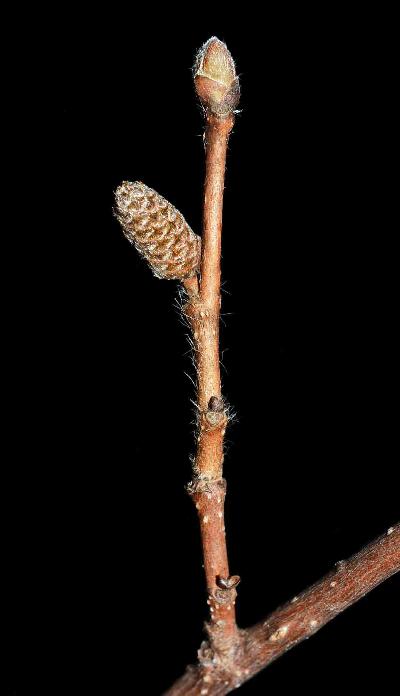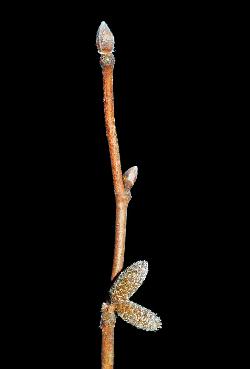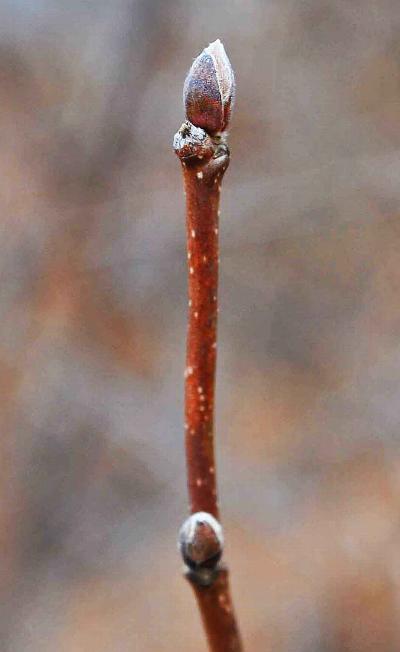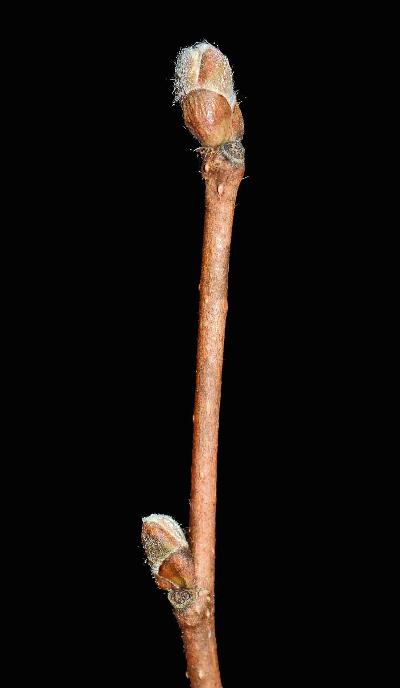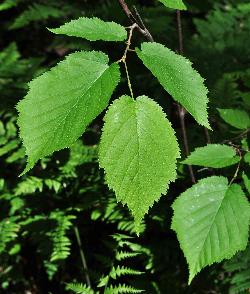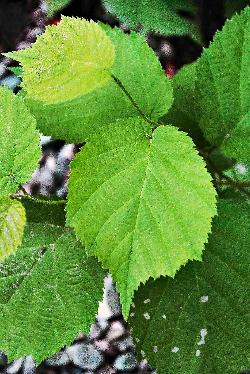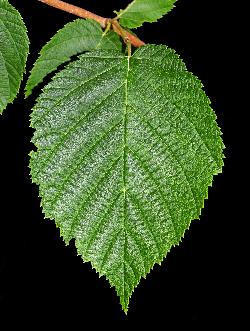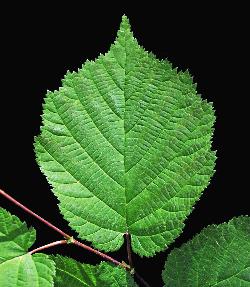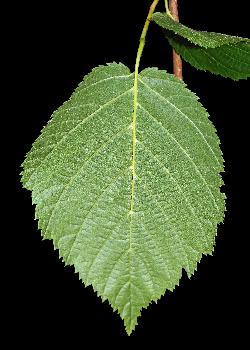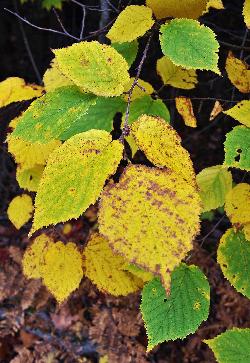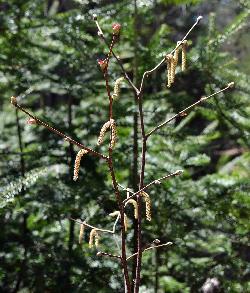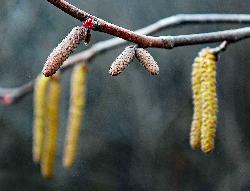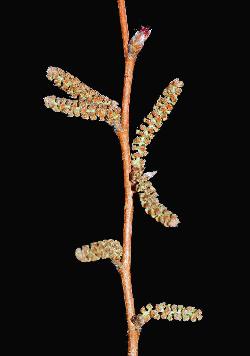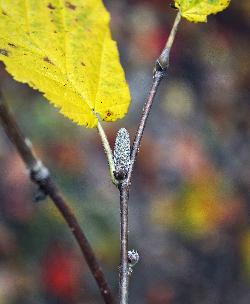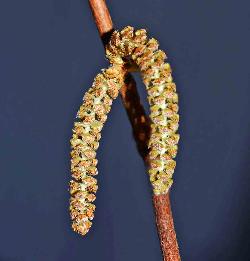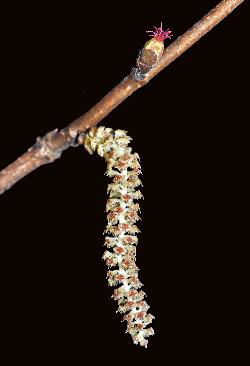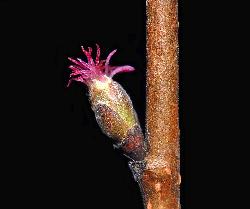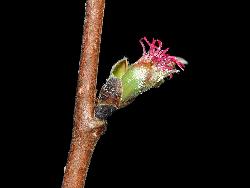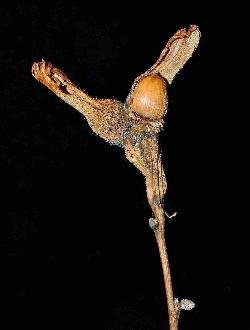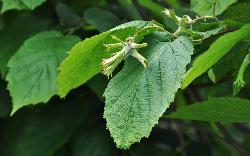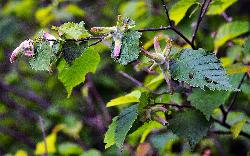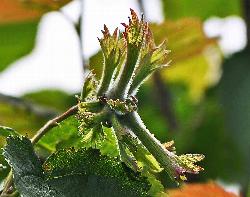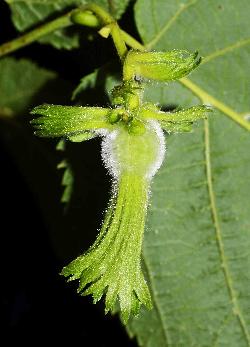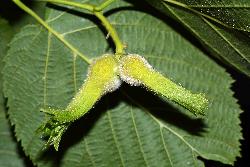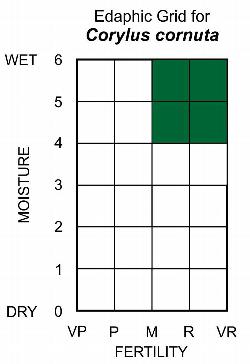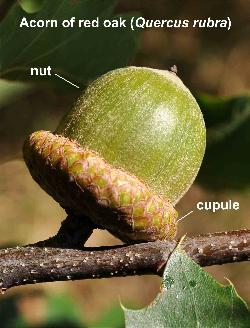Fr: noisetier à long bec, coudrier à long bec
IA: pakanakashi
Betulaceae - Birch Family
Note: Numbers provided in square brackets in the text refer to the image presented above; image numbers are displayed to the lower left of each image.
General: An open, medium-sized deciduous shrub, to 3–4 m tall [1]. Beaked hazel is moderately shade-tolerant and rhizomatous, capable of forming dense thickets; it also produces root sprouts after fire. Moose and beaver will browse on the stems, while bears, small mammals, and a variety of birds will eat the nuts (Fryer 2007). Of the 2 subspecies of Corylus cornuta, the one present in Newfoundland and Labrador, and found across southern Canada, is subsp. cornuta.
Key Features: (numbers 1–3 refer to the illustration [2])
1. Leaves are elliptic to obovate with rounded to cordate bases; the lower surface is downy pubescent.
2. Leaf margins are biserrate, with short triangular lobes, mainly in the upper half of the blade.
3. The fruit is a hard thin-walled nut, surrounded by a bristly involucral bract that narrows above the nut and is at least twice the length of the nut.
Stems/twigs: Twigs are reddish-brown and glabrous or sparsely hairy, and often bear 1–3 male overwintering catkins below the terminal bud [3–4]. Buds are alternate, ovate, reddish-brown to dark brown, and blunt to pointed (obtuse to acute) at the apex; the 4–6 imbricate bud scales are finely hairy [5–6]. Leaf scars are oval to triangular with rounded corners and have 3 bundle-trace scars. Flower buds are 3–5 mm long. Mature stems have glabrous greyish-brown bark.
Leaves: Alternate, simple, pinnately-veined, and petiolate. Petioles are 8–18 mm long, with scattered hairs or nearly glabrous. Leaf blades [7–10] are ovate, broadly elliptic, obovate, or nearly orbicular, 5–12 cm long by 3.5–12 cm wide, thin-textured (membranaceous), especially in shaded habitats, dark green and usually glabrous and dull above, paler and downy-pubescent beneath [11], especially along the veins. Leaf bases are rounded to cordate, the apex is usually abruptly pointed (acuminate), and margins are coarsely double-serrate (biserrate) with several short triangular lobes, mainly in the upper half of the leaf. Leaves turn yellow in autumn [12].
Flowers: Unisexual; shrubs monoecious, with separate male and female catkins borne on the same tree and branch [13–15]; catkins usually emerge before the leaves. Overwintering male (staminate) catkins occur in groups of 1–3, adjacent to lateral buds and borne on short peduncles, 0.5–2 mm long [3–4, 16]. The pale greyish-brown catkins are short-cylindrical, blunt, and initially less than 2.5 cm long by 0.5–0.8 cm wide, but become pendant and elongate to 6 cm long when shedding pollen [17–18]. Each bract of the catkin subtends 3 male flowers, each with 4 stamens. Female (pistillate) catkins are very short and included within overwintering buds; each densely hairy bract subtends 2 small flowers, composed of a single pistil with an inferior ovary. During anthesis, the deep red stigmas are often the only part of the flowers visible from between the somewhat persistent bud scales [19–21]. Pollination is by wind (anemophily).
Fruit: A cluster of 2–6 edible nuts, ovoid, about 12 mm long, with a hard but thin-walled shell that tapers toward the tip [22]. Each nut is surrounded by a bristly involucre, formed by 2 bracts that are fused (connate) into a tubular beak-like involucre [23–24]. The 'beak' is at least twice as long as the nut, narrows above the nut, and is divided at the end into several oblong pointed lobes [25]. The involucre is initially green [26–27], but becomes brown as the nut matures [22, 28]. Dispersal of the nuts is by small mammals, which scatter-hoard the nuts (a type of zoochory) (Furlow 1997, Vander Wall 2001).
Ecology and Habitat: Beaked hazel occurs most frequently in somewhat-wet to wet nutrient-rich forests and alder swamps. The absence of beaked hazel from the Northern Peninsula appears to be due to the growing season being 50 days shorter between the tip of the Northern Peninsula and the more southern locations where beaked hazel occurs (Damman 1976).
Edaphic Grid: See image [29]: the Edaphic Grid for Corylus cornuta.
Forest Types: Beaked hazel occurs with low abundance in the following forest types:
Abietum rubetosum – wet variant (Rubus-Balsam Fir Forest Subassociation – wet variant)
Alnetum typicum (Moist-Alder-Black Spruce Swamp Subassociation)
Betuletum typicum (White Birch-Mountain Alder Forest Subassociation)
Succession: Within Newfoundland, beaked hazel is relatively uncommon, but can persist in naturally open wet nutrient-rich forests with disturbance from windthrow, flooding, or unstable talus slopes. In other parts of its range, it is classified as a moderately shade-tolerant species, frequently found in early seral plant communities, particularly those associated with aspen and birch. It is known to rapidly increase in density and height from the root crowns and rhizomes following overstorey removal by cutting or burning (Fryer 2007). Similar observations have been made from stands containing beaked hazel after spruce budworm infestations (Batzer and Popp 1985).
Distribution: Beaked hazel occurs primarily in western Newfoundland, with sporadic records in the southern, central, and eastern regions of the Island. It is absent from the Northern Peninsula and Labrador. Beaked hazel occurs across Canada, extending from western and southern Newfoundland west to northern British Columbia. In the United States, it is found in the Great Lakes States and along the Atlantic Coast as far south as Mississippi (Furlow 1997).
Similar Species: Beaked hazel leaves are similar in appearance to those of speckled alder (Alnus incana (L.) Moench subsp. rugosa (DuRoi) R.T. Clausen); both have cross-veins between the secondary veins that meet, forming ladder-like connections [10]. Speckled alder can be recognized by its firmer glabrous leaves, compared to the membranaceous leaves of beaked hazel, which are downy pubescent on the lower surface and have more sharply biserrate margins. The buds of speckled alder are stalked, with 2 valvate scales, while beaked hazel has sessile ovate buds with 4–6 pubescent reddish-brown bud scales. Also, rather than nuts enclosed within an elongate involucre, the pistillate catkins of speckled alder develop into woody cone-like fruiting catkins, with each bract subtending a small winged nutlet.
The nuts of beaked hazel may be mistaken for acorns [30], which are the fruit of oak (Quercus) trees, not native to Newfoundland and Labrador; however, some oak trees are planted in urban areas of the Island. The bristly beaked involucre of beaked hazel is replaced in oak fruit by a subtending cup-shaped involucre (cupule) composed of numerous small overlapping bracts. The nut of the acorn can be differentiated from beaked hazel nuts by its more rounded apex, which tapers abruptly to a small apiculate tip. The nut of immature acorns is green, but matures to a warm brown colour.
European hazel (Corylus avellana L.) is a western Eurasian species that can be found growing in parks in St. John’s, NL. Leaves and flowers are similar to those of our native beaked hazel, but the beakless fruits are clearly different. The nuts of European hazel are subtended by 2 open bracts that are somewhat dissected at the margin and are about half the length of the nut.


